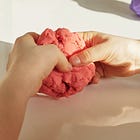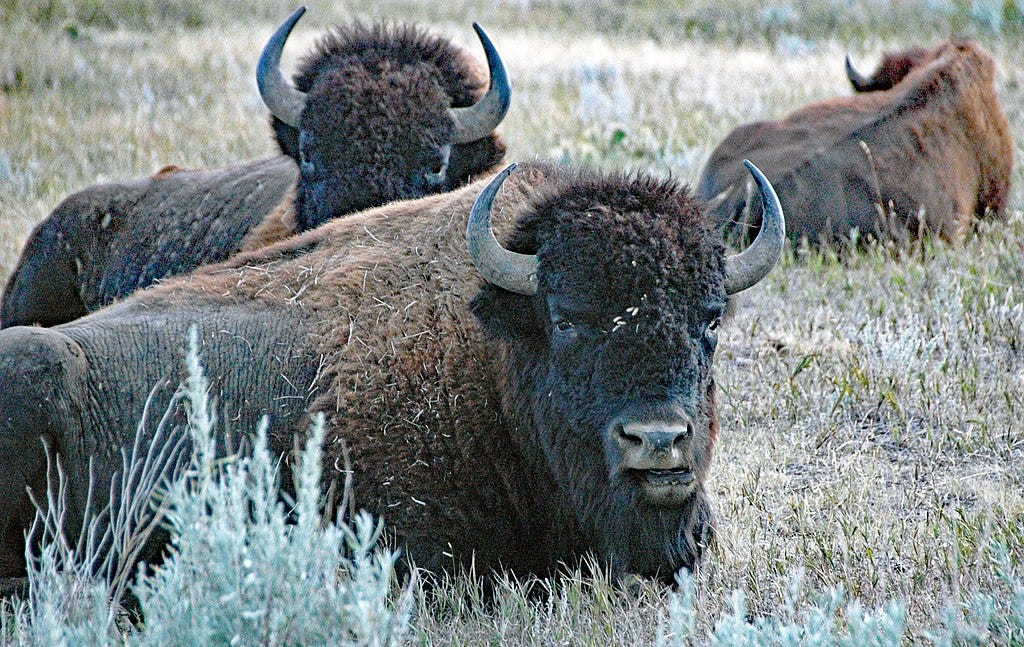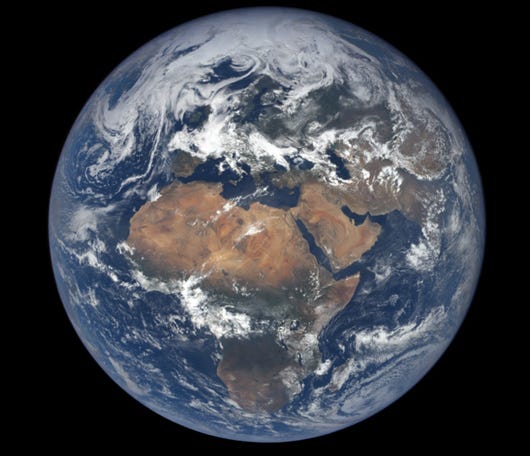The First Person and the Garden
The companion to last week's story, Let Us Make People, this is for children ages 4 through 12.
These stories stand alone, but they were originally one story. If you missed last week’s, you can begin with it and then move on to this week’s.
The First Person and the Garden
God looked around the world He was creating.
Sun, moon and stars filled the skies.
Water lapped the shores of lakes and seas,
and flowed along rivers and tiny streams,
down mountains, across plains, into valleys, and finally back to the seas.
The deserts, beaches, fields and forests were filled with creatures.
But God wasn’t finished.
He also wanted people.
He had planned to make lots of people
using the yellow, brown, black, red, and white clay from all over His new world.
But the angels showed Him there was a problem:
Different colored people would probably fight over which color was best.
God Did Not Want That!
So He pounded the colorful clay
and kneaded it until it was all mixed together.
He took the clay and shaped a person.
One yellowish-brownish-blackish-reddish-whitish person.
He breathed into the First Person.
Its chest rose and fell.
Its toes started to wiggle, and then its fingers.
When it was wiggly all over, God set it carefully in the garden of the new world.
The person stretched in the warm sunshine.
It stamped its feet,
ran through the grass,
waded in cool water,
and smelled the flowers.
Photo by Robin Webster, CC BY-SA 2.0, via Wikimedia Commons
It looked at all the growing things and gave them names:
papaya tree and peach tree,
peony and petunia,
pepper, parsley and persimmon.
It named the winged creatures
canary and cardinal,
chickadee and chicken,
kingfisher, killdeer and coot.
The sea creatures it called
sunfish and starfish and swordfish,
shrimp and salmon and smelt.
It called the earth creatures
ermine and armadillo,
elephant and elk,
bear and beaver and buffalo.
Photo by James St. John, CC BY 2.0, via Wikimedia Commons
God and the angels watched and listened so they could learn the new names for all the creatures.
When the First Person had named everything in the world, it sat down. It leaned back against a tamarind tree, hung its head, and sighed.
“Oh dear,” said an angel. “The First Person is sad!”
“You’re right,” said God.
“Why are you sad, Person? You have a whole world to enjoy. Why aren’t you happy?”
“I’m lonely,” said the First Person.
“True,” said God. “It isn’t good for you to be alone. But I tried making many people. It didn’t work.” He gave the angels a stern look.
Then He continued, “In time, you’ll make other people. Then you’ll have company.”
The angels nodded to each other. It seemed like the best way.
“But I need someone now,” exclaimed the First Person.
“Ponies and parrots are fine, but people need people. Can’t You give me a friend?”
The angels looked at each other. They couldn’t think of any way God could give the First Person a friend without causing trouble.
God sighed. Then He said to the First Person, “I can take some clay from you and use it to make another person. Then both of you will be from the same Very First Person. Close your eyes and sleep.”
Carefully He divided the clay of the first person into two people. He set them in the garden and whispered, “Wake up!”
The two people opened their eyes and looked at each other. The male person smiled at his new friend. “My name is Man,” he said to her. She smiled and said, “My name is Woman.”
God touched their heads lightly with His huge hand.
“See, here is your wonderful world. I’ve filled it with delicious foods to eat and with bright flowers. With soaring birds and silvery fishes.
Treasure it. Take care of it!”
Woman took Man’s hand. Together they walked slowly around the garden of the world.
They told each other the names of the creations—skunk and squash, nighthawk and narcissus, coyote and cabbage and carp.
Together they smelled some sweet roses, patted a soft, wooly sheep, and brushed away a mosquito.
Then God gestured to His angels. “Come.” They all moved away from the new world, toward the deep places of the universe.
Photo by NASA, Goddard Space Flight Center
God looked back at everything that He had made.
He looked at the heaven and earth, and He smiled.
He looked at the sun, moon, and stars, and His smile grew.
He looked at all the growing things and creatures, and at one yellowish-brownish-blackish-reddish-whitish Woman and one yellowish-brownish-blackish-reddish-whitish Man walking hand and hand through the world.
“Ah,” He said to His angels. “Now, at last, My creation is finished. Now, it is very, very good.”
For Parents, Teachers, and Others
This story, along with Let Us Make People, was originally published as one longer tale called The Sixth Day in the anthology Spinning Tales, Weaving Hope, published by New Society Publishers in 1992. The “sixth day” refers to the sixth day of creation, on which God created people. Minor changes have been made in the stories in order to permit them to stand alone.
This story is especially relevant in today’s crazy world because it addresses three of this age’s hot topics:
racism
environmentalism
transgenderism.
Racism: this important theme was addressed in Let Us Make People as well as in this story. Racism is not a theme in the Bible. In modern Israel today, regardless of the blather about apartheid, race is a non-issue. I have several friends with partners of very different skin tone; what are called “interracial marriages” in the USA are taken in stride here. Any problems raised by marriage partners with widely different skin tones are issues of culture because their ancestors lived in different parts of the world—from, for example, Yemen and Poland. We are Jews; outside of converts most of us have never seen ourselves as white.1
The Torah instructs us to treat everyone well. And we hope non-Jews are living decent lives according to the seven laws of Noah.
Here is a brief list of these seven laws; they are explained in more depth here.
Embrace God’s Oneness2
Do not curse Him
Guard human life
Respect animal life
Respect the property of others
Live a moral family life
Ensure justice
These laws need to be followed for any society to function smoothly. Failure to adhere to these laws creates chaos, as we see from recent history:
The Hamas War—the events of October 7 clearly break #3, #4,3 #5, #6 and #7.
The riots following George Floyd’s death: #5 was ignored broadly, but #3 was also ignored.
The LBGTQ+ movement ignores #6.
The weaponization of the US Dept. of Justice and, during the Corona crisis, of the CDC, are examples of the abrogation of #7.
Environmentalism: In today’s story, God charges the first people with the task of treasuring and taking care of the world. This involves Noahide laws #4, 5, and 7.
God’s command to Adam and Eve to take care of the land and all that is in it appears first in Genesis 1:28-30.
Jewish environmentalism is a huge topic. I touched it briefly in Environmentalism and Jewish Law in January.
You might want to show children pictures of the natural beauty of the world and the skies. I find the pictures on wikimedia commons more interesting and of higher quality than those on google images.
Transgenderism and LGBTQ+: This story shows that God made man and woman, and that they were made differently. There is no question or room for “mistakes” here. Genesis 1:27 spells it out: “And God created man in His image; in the image of God He created him [the very first person]; male and female He created them [taking Adam’s rib to make Eve].”
The Torah is very, very clear about sexual morality, with laws spelled out in detail Leviticus 18:6-24. There are other mentions of sexual morality in the Torah as well. Judaism is clear that same-sex sex is wrong, just as stealing and coveting are wrong. It is the behavior, not the person doing the behavior, that is aborrent.
In other places Judaism teaches that we all have individual challenges that He has given us to foster our unique growth. Avoiding desires that we have for things that are bad should be a major part of our growth.
Thinking Exercise 1: seeing differences and similarities
This is a classroom exercise that could be adapted to a parent-child conversation. It is best suited if you are comfortable talking about your size, religion, weight, color, ethnic group, age, physical handicap, etc.
With the polarization of races and DEI (diversity, equity and inclusion) being taught in public schools, it is important for children to become aware of the many kinds of differences between people, and to be aware of the many, many similarities. Help them understand that the basics are the same; only the details change.
Tell your class, “Look around the room. Notice the ways people are different.” After a few moments, say, “Some people are very sensitive about how they’re different, so don’t mention any names. Just tell us some of the differences you see.” Skin tone, hair and eye color, weight, and height are the most obvious differences. Glasses and braces and possibly how people dress are others. Children will vary in the characteristics that they notice.
Say, “Now look around again. This time look at how people are alike.” Help them see that the similarities are bigger than the differences: everyone has one head, two eyes, etc.
Get them to talk about talents and abilities, and be sure everyone has a chance to speak. Besides academic skills, get them to talk about other things: enjoying helping Dad fix the car, babysitting a younger sibling, or washing the dishes. If you know there is a tomboy or an effeminate boy in the class, be sure that they mention the things they do that are more common for the opposite sex. Especially with the transgenderism today, children need to be validated for being the sex they are and simultaneously enjoying things that are more commonly associated with the other sex.4 This is also the time to educate to prevent teasing of artistic boys and rough-and-tumble girls.
Lead them to recognize that there is a huge variation in interests and native abilities, and that all are okay (as long as they don’t controvert the Laws of Noah) because we are all made in the image of God.
It is, in today’s world, especially important for children to understand that interests and abilities are on a spectrum.
Thinking Exercise 2: cultural differences
Ask: “What do you like to eat when you’re sick?” There will be a wide variety. Then ask, “How would you feel if you got chicken soup instead of jello and ginger ale?”
Explain that these differences are cultural. Within the limits of the Seven Laws of Noah, there’s basically no right or wrong. Different families , different nationalities, and people from different places answer these questions differently:
What time is mealtime?
What do you eat for breakfast?
What’s in your lunch box?
If anyone in your family dresses differently from most people, how and why?
Do you celebrate birthdays? How?
What do you call your grandparents?
Help them see that things “feel right” because they are familiar, not because they are higher on a universal rightness scale than other things.
At the same time, it is exremely important to point out that if a cultural or religious behavior breaks one of the Noahide laws, a value judgment can and should be made. Human sacrifice, for example, whether in ancient times or today (when someone straps on a suicide belt and blows himself up as a holy act), is not acceptable in western civilization, the culture that supports it is not on the same level, and those who believe it need to adapt to the higher culture or expect to be marginalized.
Summary
This story and its partner can be read to small children just for the general idea and the poetic language. The ideas can be discussed with older children.
Humanity started out the same, but changed. The changes make life interesting. Not all cultures are equally good, though. Some do not value the Seven Laws of Noah, and the people who follow those cultures make trouble for everyone else.
In fact, far from seeing myself as white, especially when I was younger I was often asked what my race was because I was clearly—from my sallow skin, dark hair and eyes, and clearly Ashkenazi features— not European. For three years I taught mostly Saudi Arabian students ESL in a college-prep program. At first, they asked me where my ancestors came from, and if I was sure I was not Arab. When I said I was sure, they said, “Then you must be Jewish.” After a few months, when I realized they were not educated in Jew-hatred like Muslims of Jordan, Ethiopia, and Egypt, I just told them I was Jewish. Far from disdaining me, they told me they trusted me more than other teachers because I looked like their grandmothers, wore modest clothing, and covered my hair.
The Hindu religion has many gods and is considered idolatrous by Jewish standards. However, in a classroom setting, if this issue comes up I would say that the Hindu gods are manifestations of the Supreme Absolute (Brahman). This is according to Subhamoy Das, author of Hindu Gods & Goddesses, in Learn Religion, www.learnreligions.com/why-hiindus-have-so-many-gods-1769466, accessed Feb. 8, 2024.
Many pets were slaughtered and farm animals left with no one to feed and water them.
I once heard a talk on NPR by David Sedaris where he talked about how he realized he was gay. He said that he was small, unathletic, and loved poetry and art. The other boys called him gay, and he decided they must be right. Pitiful! As a point of reference, I had two grandfathers who were under 5’3”. Both were artists—one professionally and one a hobbiest—and the pro artist also played piano like a pro while the other (who left school after 6th grade) knew most of Shakespere by heart. They both would have punched the lights out of anyone who had called them gay.






